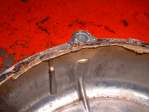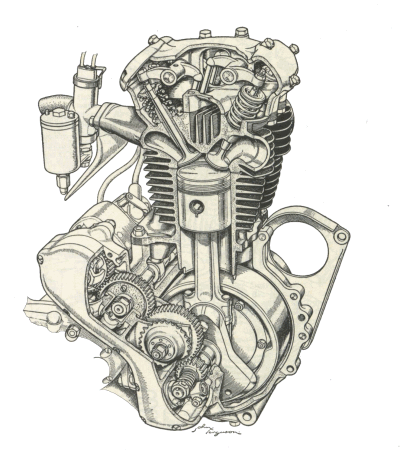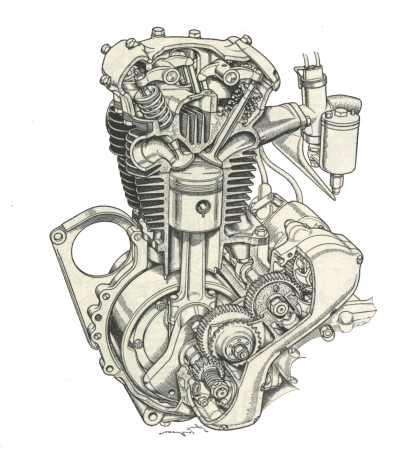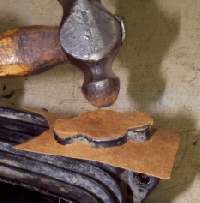"When I was a child, I spake as a child, I understood as a child, I thought as a child:
But when I became a man, I put away childish things."
¶ If you are going to be a good mechanic you've got to put away childish things. One of these things is using gasket cement everywhere. Gaskets are made to expand just a little when oil hits them. This makes a good, oil tight seal. If your sealing surfaces are smooth and you have a new gasket, you simply do not need gasket cement. A real sign of an amateur is lots of slobbery gasket cement. So do you put the gasket on dry? No, you use plain ordinary wheel bearing grease. I use grease on all new gaskets except the ones that come from the factory with a special coating already put on. The grease serves several functions.
- It will hold the gasket in place as you put the two pieces together.
- It allows the gasket to move around a bit as you put in the screws.
- It starts the swelling process that the oil will finish.
- It allows you to disassemble things easily if an error is made and allows you to reuse the same gasket after you fix that error. Not that I ever make errors... well... I did once. I thought I had made an error, turned out I hadn't.
- It allows easy disassembly in the dim, dark future.
 Is there a time to use gasket cement? Yes indeed. If there is a gouge or nick in the sealing surface, it will need to be filled in gasket cement. Sometimes no gasket is called for and the two parts are sealed with a gasket cement. There are many types out there. Get several that are sold in your area and see which one you like. I prefer the non hardening kind and I don't like any of the silicon seal types. The silicon seal types tend to ball up inside the engine and come loose plugging the oil screens and choking off the oil flow... not good. So what do we use?
Is there a time to use gasket cement? Yes indeed. If there is a gouge or nick in the sealing surface, it will need to be filled in gasket cement. Sometimes no gasket is called for and the two parts are sealed with a gasket cement. There are many types out there. Get several that are sold in your area and see which one you like. I prefer the non hardening kind and I don't like any of the silicon seal types. The silicon seal types tend to ball up inside the engine and come loose plugging the oil screens and choking off the oil flow... not good. So what do we use?
I really like YamaBond #4. It's a gray gooey cement used to join the crankcase halves of Yamaha 2/strokes. It doesn't ball up. Any excess inside the engine seems to flatten out and sticks to the side of the crankcases. I use it for any metal to metal sealing jobs where there is no gasket. I use it even if another sealant is called for because it works so well. Works good with gaskets too. You used to be able to get it from Yamaha but not anymore apparently. The good news is ThreeBond has a replacement that seems to work just as good. It is ThreeBond Liquid Gasket #1194. I don't use the silicon seal stuff at all. Not any brand... too many baaad experiences.
Always use new gaskets. They are not that expensive. Reusing old gaskets is not a good idea but can be done in an emergency if they are in good condition. Here you can and should use gasket cement.
Gaskets come in different thickness. Sometimes the gasket thickness is used to set the side clearance on the shafts that pass through a crankcase. So if you make your own gaskets be sure to match the thickness of the old to the new.
 You can make your own gaskets if the shape is not too complicated. This works quite well for something like base gaskets. In fact, if you make and stack several base gaskets it can lower the engines compression ratio so you can use lower octane gas. However, I don't suppose anyone wants to do that any more.
You can make your own gaskets if the shape is not too complicated. This works quite well for something like base gaskets. In fact, if you make and stack several base gaskets it can lower the engines compression ratio so you can use lower octane gas. However, I don't suppose anyone wants to do that any more.
To make a gasket simply lay a piece of gasket material on to the part, like a clutch cover or cylinder. Take the ball end of a Ball Peen Hammer and tap along each edge gently. You will find this cuts the pattern of the part into the gasket. It helps if you have a set of hole punches too. If you are careful you can make a fairly complicated gasket. It can take quite a bit of time. All in all, just buy them.
 It goes without saying that all of the old gasket must be removed and that you don't want to nick or gouge the metal surface. A big help in this is liquid gasket remover. You can get it in a spray can or in a brush on can. I like the spray. It just seems to work better. Just spray it on and wait awhile. If the gasket is still hard, spray it several times and wait overnight. Try not to get any on you. It is somewhat caustic. A special gasket removal tool will help too. Sometimes it helps to use a circular wire brush mounted on a bench grinder. Be very careful. The steel wire in the brush can eat into the aluminum if you push too hard. ALWAYS wear eye and face protection. The circular wire brushes spit out strands of wire and they do it a lot.
It goes without saying that all of the old gasket must be removed and that you don't want to nick or gouge the metal surface. A big help in this is liquid gasket remover. You can get it in a spray can or in a brush on can. I like the spray. It just seems to work better. Just spray it on and wait awhile. If the gasket is still hard, spray it several times and wait overnight. Try not to get any on you. It is somewhat caustic. A special gasket removal tool will help too. Sometimes it helps to use a circular wire brush mounted on a bench grinder. Be very careful. The steel wire in the brush can eat into the aluminum if you push too hard. ALWAYS wear eye and face protection. The circular wire brushes spit out strands of wire and they do it a lot.
Unfortunatly, some bikes are going to leak no matter what. Like the old British bikes. I did everything you can think of to my Norton Atlas 750, except for welding the cases. I got the leakage down to 300 miles per quart. The dealer wanted to know how I got it to be so oil tight. Some bikes are just going to leak oil, period.
So remember, new gaskets, grease, and clean metal surfaces equals oil in the engine and not on the floor... most times anyway.



 |
 |
Copyright © 1999-2001 dansmc.com. All rights reserved.
